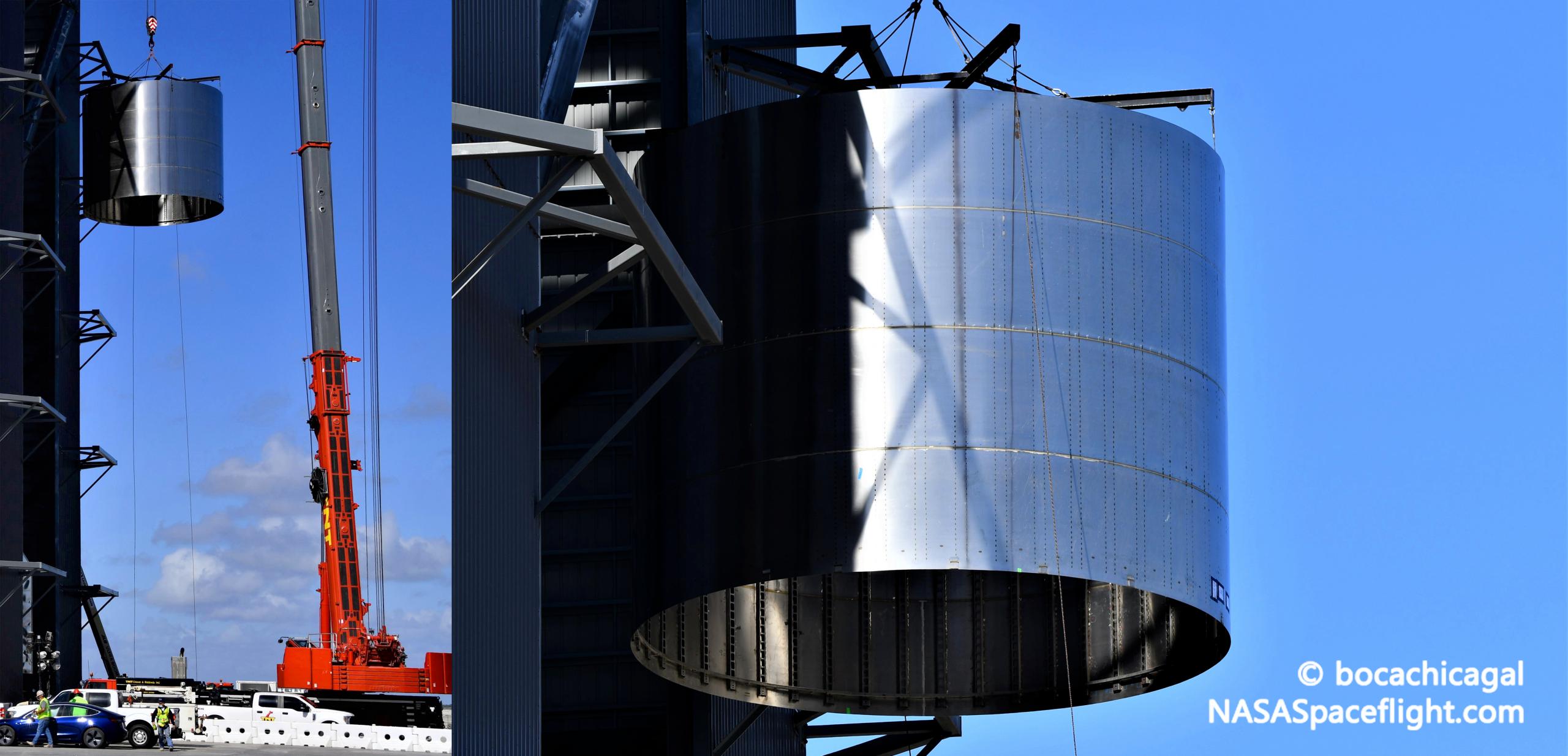
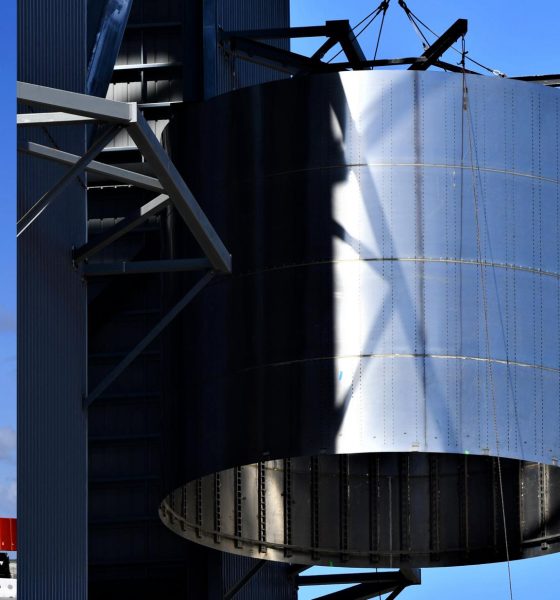
News
SpaceX begins assembling first Starship Super Heavy booster in South Texas
SpaceX has taken the first unequivocal step towards orbital Starship launches, kicking off assembly of the first Super Heavy booster (first stage) – a necessity for recoverable spaceship missions to Earth orbit and beyond.
Although SpaceX could technically get away with building much smaller booster prototypes to support Starship’s initial orbital test flights, perhaps going as far as simply modifying Starship’s proven tank design, rocketry really doesn’t lend itself to modularity. Be it out of confidence or necessity, SpaceX appears to be moving directly from Starship prototype development to full-scale Super Heavy booster production and testing.
The first conveniently labeled Super Heavy booster rings were spotted around September 22nd. In the six or so weeks since then, SpaceX’s Boca Chica, Texas factory has relentlessly churned out at least as many sections of stacked booster rings – now strewn about the ever-growing campus. No less than seven labeled Super Heavy ring sections have been spotted since the first, equating to fewer than 25 steel rings of the estimated 38-40 needed to complete each booster.
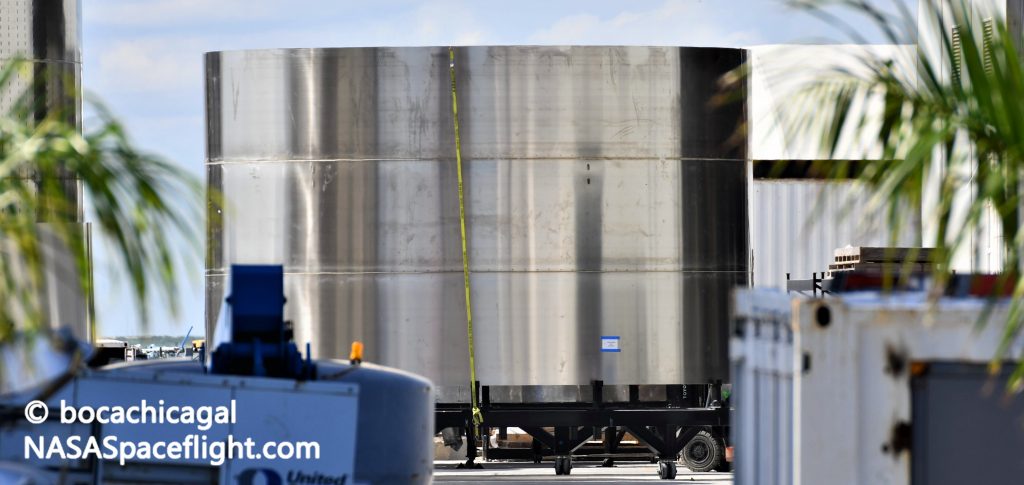
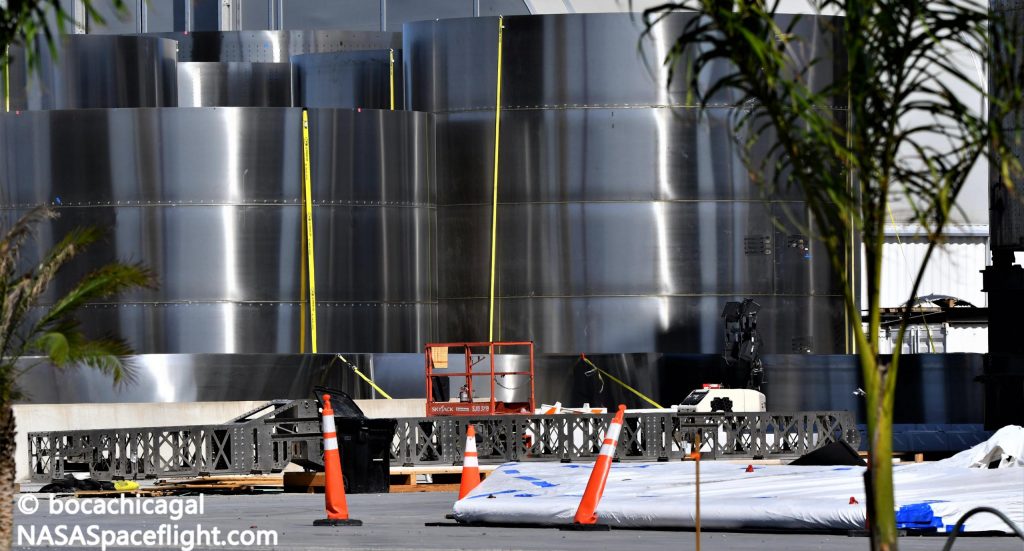
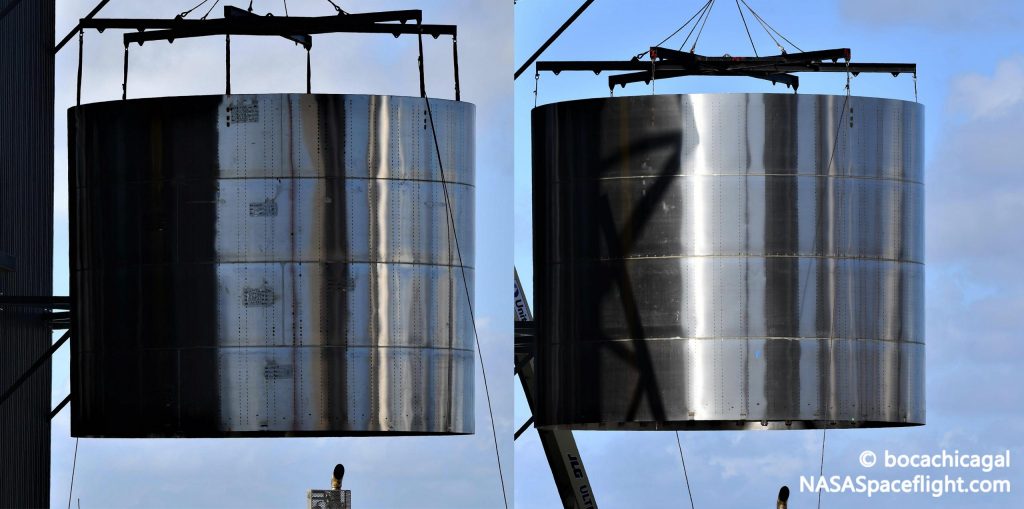
Relying on a tank design almost identical to hardware flight-proven on two separate Starship prototypes, SpaceX is able to use the exact same manufacturing infrastructure for the vast majority of Starship and Super Heavy. In fact, in a flip of the usual relationship, the next-generation rocket’s booster will most likely be far simpler than the upper stage – nominally the largest reusable spacecraft and upper stage ever attempted.
Without the need for a tiled heat shield, a conical nose section, aerodynamic control surfaces (beyond Falcon-style grid fins), or even (perhaps) internal header tanks, the only major challenge unique to Super Heavy is the development of an engine section capable of supporting and feeding as many as 28 Raptor engines. In other words, as long as the basics of Starship are successful and SpaceX is able to design a reliable 28-Raptor thrust structure and associated plumbing, Super Heavy may actually be a much easier problem to solve.
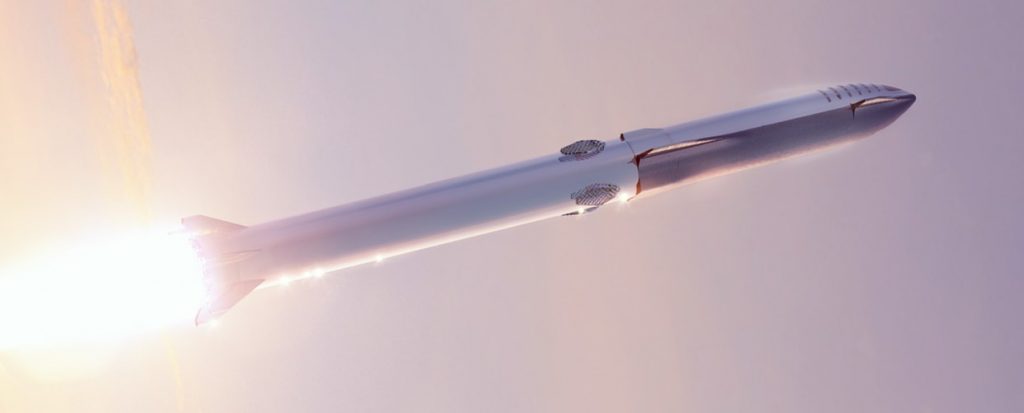
Theory aside, Starship and Super Heavy will unequivocally be the largest spacecraft, upper stage, and rocket booster ever built regardless of their success. While CEO Elon Musk recently stated that a Super Heavy booster could perform hop tests with just two Raptor engines, if necessary, the rocket is ultimately expected to have 20 high-thrust Raptors with minimal throttle capability and an inner ring of eight throttleable, gimballing engines for precision maneuvers.
With all 28 engines operating at full thrust, that particular Super Heavy design would produce an immense 6600 metric tons (14.5 million lbf) of thrust at liftoff – approximately twice the thrust of Saturn V and Soviet N-1 rockets and more than three times the thrust of SpaceX’s own Falcon Heavy. Measuring ~70m (~230 ft) tall, Super Heavy would weigh at least 3500 metric tons (7.7 million lb) fully loaded with liquid oxygen and methane propellant and – on its own – stand as tall or taller than Falcon 9, Falcon Heavy, and any other operational rocket on Earth.
Now effectively inaugurated with the first Super Heavy booster (“BN1,” according to SpaceX) hardware, the ~83m (~270 ft) tall high bay will likely be in a near-constant state of activity as teams work to stack and weld the massive steel rocket. Essential to support Starship’s first recoverable orbital launch attempts, it remains to be seen how exactly SpaceX will put the first completed Super Heavy through its paces and what the first booster-supported Starship launches will look like. Regardless, barring major surprises during assembly, Super Heavy booster #1 (BN1) could be more or less complete just a month or two from now.

News
Tesla aims to combat common Full Self-Driving problem with new patent
Tesla writes in the patent that its autonomous and semi-autonomous vehicles are heavily reliant on camera systems to navigate and interact with their environment.

Tesla is aiming to combat a common Full Self-Driving problem with a new patent.
One issue with Tesla’s vision-based approach is that sunlight glare can become a troublesome element of everyday travel. Full Self-Driving is certainly an amazing technology, but there are still things Tesla is aiming to figure out with its development.
Unfortunately, it is extremely difficult to get around this issue, and even humans need ways to combat it when they’re driving, as we commonly use sunglasses or sun visors to give us better visibility.
Cameras obviously do not have these ways to fight sunglare, but a new patent Tesla recently had published aims to fight this through a “glare shield.”
Tesla writes in the patent that its autonomous and semi-autonomous vehicles are heavily reliant on camera systems to navigate and interact with their environment.

The ability to see surroundings is crucial for accurate performance, and glare is one element of interference that has yet to be confronted.
Tesla described the patent, which will utilize “a textured surface composed of an array of micro-cones, or cone-shaped formations, which serve to scatter incident light in various directions, thereby reducing glare and improving camera vision.”

The patent was first spotted by Not a Tesla App.
The design of the micro-cones is the first element of the puzzle to fight the excess glare. The patent says they are “optimized in size, angle, and orientation to minimize Total Hemispherical Reflectance (THR) and reflection penalty, enhancing the camera’s ability to accurately interpret visual data.”
Additionally, there is an electromechanical system for dynamic orientation adjustment, which will allow the micro-cones to move based on the angle of external light sources.
This is not the only thing Tesla is mulling to resolve issues with sunlight glare, as it has also worked on two other ways to combat the problem. One thing the company has discussed is a direct photon count.
CEO Elon Musk said during the Q2 Earnings Call:
“We use an approach which is direct photon count. When you see a processed image, so the image that goes from the sort of photon counter — the silicon photon counter — that then goes through a digital signal processor or image signal processor, that’s normally what happens. And then the image that you see looks all washed out, because if you point the camera at the sun, the post-processing of the photon counting washes things out.”
Future Hardware iterations, like Hardware 5 and Hardware 6, could also integrate better solutions for the sunglare issue, such as neutral density filters or heated lenses, aiming to solve glare more effectively.
Elon Musk
Delaware Supreme Court reinstates Elon Musk’s 2018 Tesla CEO pay package
The unanimous decision criticized the prior total rescission as “improper and inequitable,” arguing that it left Musk uncompensated for six years of transformative leadership at Tesla.

The Delaware Supreme Court has overturned a lower court ruling, reinstating Elon Musk’s 2018 compensation package originally valued at $56 billion but now worth approximately $139 billion due to Tesla’s soaring stock price.
The unanimous decision criticized the prior total rescission as “improper and inequitable,” arguing that it left Musk uncompensated for six years of transformative leadership at Tesla. Musk quickly celebrated the outcome on X, stating that he felt “vindicated.” He also shared his gratitude to TSLA shareholders.
Delaware Supreme Court makes a decision
In a 49-page ruling Friday, the Delaware Supreme Court reversed Chancellor Kathaleen McCormick’s 2024 decision that voided the 2018 package over alleged board conflicts and inadequate shareholder disclosures. The high court acknowledged varying views on liability but agreed rescission was excessive, stating it “leaves Musk uncompensated for his time and efforts over a period of six years.”
The 2018 plan granted Musk options on about 304 million shares upon hitting aggressive milestones, all of which were achieved ahead of time. Shareholders overwhelmingly approved it initially in 2018 and ratified it once again in 2024 after the Delaware lower court struck it down. The case against Musk’s 2018 pay package was filed by plaintiff Richard Tornetta, who held just nine shares when the compensation plan was approved.
A hard-fought victory
As noted in a Reuters report, Tesla’s win avoids a potential $26 billion earnings hit from replacing the award at current prices. Tesla, now Texas-incorporated, had hedged with interim plans, including a November 2025 shareholder-approved package potentially worth $878 billion tied to Robotaxi and Optimus goals and other extremely aggressive operational milestones.
The saga surrounding Elon Musk’s 2018 pay package ultimately damaged Delaware’s corporate appeal, prompting a number of high-profile firms, such as Dropbox, Roblox, Trade Desk, and Coinbase, to follow Tesla’s exodus out of the state. What added more fuel to the issue was the fact that Tornetta’s legal team, following the lower court’s 2024 decision, demanded a fee request of more than $5.1 billion worth of TSLA stock, which was equal to an hourly rate of over $200,000.
Delaware Supreme Court Elon Musk 2018 Pay Package by Simon Alvarez
News
Tesla Cybercab tests are going on overdrive with production-ready units
Tesla is ramping its real-world tests of the Cybercab, with multiple sightings of the vehicle being reported across social media this week.

Tesla is ramping its real-world tests of the Cybercab, with multiple sightings of the autonomous two-seater being reported across social media this week. Based on videos of the vehicle that have been shared online, it appears that Cybercab tests are underway across multiple states.
Recent Cybercab sightings
Reports of Cybercab tests have ramped this week, with a vehicle that looked like a production-ready prototype being spotted at Apple’s Visitor Center in California. The vehicle in this sighting was interesting as it was equipped with a steering wheel. The vehicle also featured some changes to the design of its brake lights.
The Cybercab was also filmed testing at the Fremont factory’s test track, which also seemed to involve a vehicle that looked production-ready. This also seemed to be the case for a Cybercab that was spotted in Austin, Texas, which happened to be undergoing real-world tests. Overall, these sightings suggest that Cybercab testing is fully underway, and the vehicle is really moving towards production.
Production design all but finalized?
Recently, a near-production-ready Cybercab was showcased at Tesla’s Santana Row showroom in San Jose. The vehicle was equipped with frameless windows, dual windshield wipers, powered butterfly door struts, an extended front splitter, an updated lightbar, new wheel covers, and a license plate bracket. Interior updates include redesigned dash/door panels, refined seats with center cupholders, updated carpet, and what appeared to be improved legroom.
There seems to be a pretty good chance that the Cybercab’s design has been all but finalized, at least considering Elon Musk’s comments at the 2025 Annual Shareholder Meeting. During the event, Musk confirmed that the vehicle will enter production around April 2026, and its production targets will be quite ambitious.








